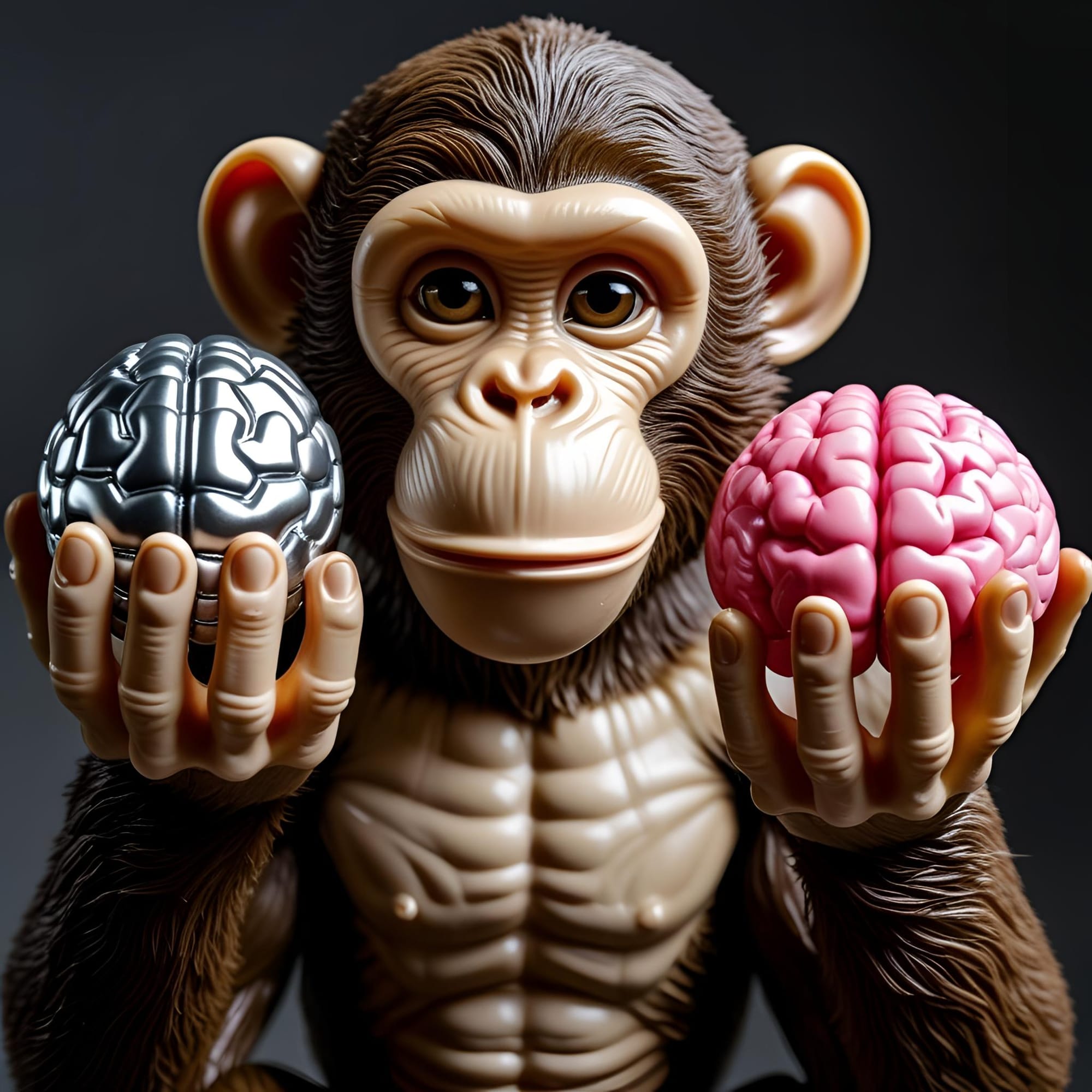Human Vs AI Neural Network Face Off
NVIDIA's Jensen Huang recently bragged that AI computing efficiency has increased 10,000 times since 2016. Impressive, sure. But your brain learnt to optimise itself long before GPUs became a thing, and it doesn't need a server farm to do it.

Who's Circuitry is Better?
In the race to create artificial intelligence, we've stumbled upon something humbling: the most sophisticated information-processing system already exists. It's currently reading these words.
Fast fact: Your brain processes 11 million bits of information every second whilst consuming roughly the same power as a dim light bulb. The latest AI models? They require enough energy to power a small city. Even more telling: AI researchers are now literally growing biological neurons (BioNode, Cortical Labs) because silicon still can't match your brain's efficiency. When the future of AI is actual neurons in petri dishes, maybe your meat computer isn't so primitive after all.
Silicon Valley might be winning at data, but nature still wins at efficiency.
Nature's Architecture: A Blueprint Silicon Valley Keeps Borrowing
The world's most advanced neural networks are, at best, reverse-engineered approximations of your brain's architecture. When you learn something new, your brain performs what AI engineers call backpropagation - adjusting neural pathways based on feedback. But your brain doesn't just log errors; it fine-tunes its entire system with elegant precision.
NVIDIA's Jensen Huang recently bragged that AI computing efficiency has increased 10,000 times since 2016. Impressive, sure. But your brain learnt to optimise itself long before GPUs became a thing, and it doesn't need a server farm to do it.
Meanwhile, Singapore's latest breakthrough proves the point: their Hierarchical Reasoning Model (HRM) just outperformed OpenAI and Claude using 27 million parameters versus their billions - by copying your brain's two-layer architecture. Turns out the solution to better AI wasn't more data or bigger models. It was better organisation. Like yours.
Your Brain's Natural Advantage
Understanding your brain as a neural network reveals how extraordinary we are. When you learnt how to ride a bike, the skill stuck with you permanently. Your brain instinctively extracted core principles - balance, motion, coordination - and seamlessly rewired itself. AI researchers call this "transfer learning." Your brain calls it Tuesday.
But it doesn't stop at practical skills. Your brain excels at emotional intelligence and intuition, making split-second decisions driven by gut instinct and nuanced emotional context. Modern AI, despite its advances, is still catching up with subtlety, intuition, and emotional complexity. For now.
Here's how biological and artificial systems compare:
The Human Neural System
- Processes multiple data streams simultaneously
- Adapts instantly based on context
- Operates with minimal energy consumption
- Self-repairs and strengthens critical pathways
- Learns from single instances
- Masters hierarchical processing: abstract planning + detailed execution
Current AI Systems
- Excel at narrow, specific tasks
- Require massive datasets to learn
- Consume significant energy
- Need external optimisation
- Struggle with novelty
- Learning to copy hierarchical processing (and winning when they do)
The Integration Challenge: The Rise of the iSelf
Recognising the power of your biological neural network isn't just philosophical - it's deeply practical. As we navigate the emerging concept of the iSelf - the fusion of our biological and digital identities - this understanding becomes crucial. Balancing your offline and online selves harmoniously can enhance focus, decision-making, and resilience, empowering rather than overwhelming your brain during a time when technology advances are leaving our heads spinning.
Here's why this matters:
Focus Preservation: Digital overload fragments attention; optimised habits strengthen concentration.
Decision Clarity: Better input management improves cognitive clarity and reduces mental fatigue.
Emotional Resilience: Strategic engagement and disengagement support mental health and wellbeing.
Here's how you can practically apply neural-network-inspired optimisation protocols:
Optimisation Protocols: Avoiding Burnout for Both Neural Networks
Both artificial and biological neural networks face a fundamental challenge: optimising performance whilst preventing burnout. In AI development, we employ a technique called "dropout" - randomly deactivating neural connections during training to prevent overreliance on any single pathway. Your brain employs a more sophisticated version during sleep, pruning unnecessary connections whilst strengthening critical pathways.
Your brain, like AI neural networks, thrives when optimally managed. Implementing structured optimisation strategies can protect your mental health, enhance productivity, and maintain your human advantage.
Input Quality Control
Your brain operates on the same principle as any neural network: garbage in, garbage out.
Implement these specific protocols:
Information Diet Design: Create three distinct content streams:
- Core expertise (60%): Deep, focused material in your primary field
- Adjacent insights (30%): Related fields that create novel connections
- Random exploration (10%): Entirely new domains for cognitive flexibility
Environment Engineering: Structure your physical and digital workspace:
- Establish a "deep work" zone with zero notifications
- Create a "learning station" with all necessary tools pre-positioned
- Design a "reflection space" free from digital devices
Digital Consumption Protocol:
- Implement a 50-minute focus/10-minute integration cycle
- Use physical note-taking for primary processing
- Schedule specific times for social media and news consumption
Processing Optimisation
Enhance your brain's natural learning mechanisms with these structured approaches:
Biological Learning Patterns:
- Peak learning periods: Track your energy levels hourly for a week
- Match complex tasks to your identified high-energy periods
- Use the 90-minute ultradian rhythm for work/rest cycles
Deliberate Practice Protocol:
- Morning: 25-minute deep learning session before email
- Afternoon: Two 45-minute skill application periods
- Evening: 15-minute reflection and connection-making
Neural Consolidation Strategy:
- Schedule 10-minute breaks between learning sessions
- Implement a mandatory 20-minute daily meditation
- Design a pre-sleep review ritual lasting 5-10 minutes
Your Architecture is Being Reverse-Engineered (And It's Working)
Whilst you've been optimising your neural networks through meditation and sleep cycles, AI researchers hit a wall. Chain-of-thought reasoning - the dominant AI approach - requires massive datasets and fails on complex problems that your brain solves effortlessly.
The breakthrough? Hierarchical Reasoning Model (HRM) literally copies your brain's structure: a high-level module for slow, abstract planning paired with a low-level module for rapid, detailed computation. The results are humbling for Silicon Valley.
The scorecard: HRM (27M parameters) outperformed OpenAI's o3-mini-high and Claude 3.7 on reasoning benchmarks using 1,000 training samples where billion-parameter models failed completely. Near-perfect accuracy on complex Sudoku puzzles and maze-solving that stumped state-of-the-art AI.
Translation: Your brain's organisational principles are so efficient that AI companies are abandoning the "scale everything" philosophy to copy your homework. The most advanced reasoning system operates by thinking like you think.
Output Refinement System
Create measurable feedback loops for continuous improvement:
Learning Verification:
- Teach concepts to others within 24 hours of learning
- Write one-page summaries of key insights
- Create mind maps connecting new information to existing knowledge
Skill Application Framework:
- Morning: Plan three specific applications of new learning
- Day: Execute and document results
- Evening: Analyse outcomes and adjust approach
Performance Metrics:
- Track learning retention through spaced repetition
- Measure application success rate weekly
- Document unexpected connections and insights daily
This framework isn't about perfection – it's about progressive optimisation. Start with one protocol from each category and expand as you build competence. Remember: your neural architecture thrives on systematic challenge, not sporadic effort.
Continuous Improvement: The Future of Neural Integration
Both biological and artificial neural networks share one core principle: continuous optimisation. Your brain thrives on challenge and adaptation. With the changes we are all about to experience, it's important to intentionally iterate the steep learning curve.
In software development, we call this Continuous Integration/Continuous Deployment (CI/CD).
Apply the same approach to your personal growth:
Version Control: Reflect regularly on personal changes and progress.
Testing Environment: If your life goals aren't working out the way you want, try experimenting with new behaviours and mindsets in low-risk scenarios. Learn to pivot your beliefs.
Deployment Strategy: Gradually implement successful strategies into broader areas of your life.
Nature Knows Best
Why should you integrate neural-network-inspired protocols into daily routines and digital habits?
Because without intentional management, the digital environment can overwhelm your biological strengths, leading to burnout, confusion, and stress. These protocols ensure that your engagement remains purposeful, sustainable, and aligned with your biological rhythms.
Whilst AI evolves by copying your neural network, it still can't replace what you already have. Even breakthrough models like HRM succeed by mimicking your hierarchical processing - they're not inventing new intelligence, they're reverse-engineering yours. The most sophisticated AI breakthrough operates as a tribute to your brain's architecture.
Your competitive advantage isn't threatened by AI advancement. It's being validated by it.
Before you default to systems and external automation, remember how powerful yours already is. Optimisation isn't just about becoming more efficient; it's about becoming more human.
Your brain does more than process data; it intuitively interprets emotions, nuances, and subtle signals. Emotional intelligence and intuition give you a competitive advantage no AI can match. Machines analyse data - humans understand context, nuance, and meaning.
Your brain excels at extracting meaning from minimal information. AI? It's still trying to figure out the basics. Use that to your advantage. Build systems that complement your biology, not fight against it.
The most powerful neural network isn't artificial. It's the one you've had all along.
This piece is part of a series exploring the fascinating intersections between human development and digital transformation. Stay tuned for more insights on optimising your iSelf and personal operating system.

Discussion